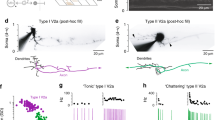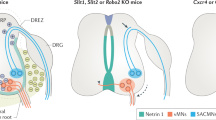Abstract
Sensory information from the periphery is integrated and transduced by excitatory and inhibitory interneurons in the dorsal spinal cord. Recent studies have identified a number of postmitotic factors that control the generation of these sensory interneurons. We show that Gsh1/2 and Ascl1 (Mash1), which are expressed in sensory interneuron progenitors, control the choice between excitatory and inhibitory cell fates in the developing mouse spinal cord. During the early phase of neurogenesis, Gsh1/2 and Ascl1 coordinately regulate the expression of Tlx3, which is a critical postmitotic determinant for dorsal glutamatergic sensory interneurons. However, at later developmental times, Ascl1 controls the expression of Ptf1a in dILA progenitors to promote inhibitory neuron differentiation while at the same time upregulating Notch signaling to ensure the proper generation of dILB excitatory neurons. We propose that this switch in Ascl1 function enables the cogeneration of inhibitory and excitatory sensory interneurons from a common pool of dorsal progenitors.
This is a preview of subscription content, access via your institution
Access options
Subscribe to this journal
Receive 12 print issues and online access
$209.00 per year
only $17.42 per issue
Buy this article
- Purchase on Springer Link
- Instant access to full article PDF
Prices may be subject to local taxes which are calculated during checkout








Similar content being viewed by others
References
Willis, W.D. & Coggeshall, R.E. Sensory Mechanisms of the Spinal Cord (Plenum, New York, 1991).
Szentagothai, J. Neuronal and synaptic arrangement in the substantia gelatinosa rolandi. J. Comp. Neurol. 122, 219–239 (1964).
Woolf, C.J., Shortland, P. & Coggeshall, R.E. Peripheral nerve injury triggers central sprouting of myelinated afferents. Nature 355, 75–78 (1992).
Fitzgerald, M. The development of nociceptive circuits. Nat. Rev. Neurosci. 6, 507–520 (2005).
Altman, J. & Bayer, S.A. The development of the rat spinal cord. Adv. Anat. Embryol. Cell Biol. 85, 1–164 (1984).
Gross, M.K., Dottori, M. & Goulding, M. Lbx1 specifies somatosensory association interneurons in the dorsal spinal cord. Neuron 34, 535–549 (2002).
Jessell, T.M. Neuronal specification in the spinal cord: inductive signals and transcriptional codes. Nat. Rev. Genet. 1, 20–29 (2000).
Goulding, M., Lanuza, G., Sapir, T. & Narayan, S. The formation of sensorimotor circuits. Curr. Opin. Neurobiol. 12, 508–515 (2002).
Muller, T. et al. The homeodomain factor Lbx1 distinguishes two major programs of neuronal differentiation in the dorsal spinal cord. Neuron 34, 551–562 (2002).
Cheng, L. et al. Tlx3 and Tlx1 are post-mitotic selector genes determining glutamatergic over GABAergic cell fates. Nat. Neurosci. 7, 510–517 (2004).
Glasgow, S.M., Henke, R.M., MacDonald, R.J. & Johnson, J.E. PTF1a specifies dorsal horn GABAergic over glutamatergic neuronal cell fate in the spinal cord dorsal horn. Development 132, 5461–5469 (2005).
Kriks, S., Lanuza, G.M., Mizuguchi, R., Nakafuku, M. & Goulding, M. Gsh2 is required for the repression of Ngn1 and specification of dorsal interneuron fate in the spinal cord. Development 132, 2991–3002 (2005).
Gowan, K. et al. Crossinhibitory activities of Ngn1 and Math1 allow specification of distinct dorsal interneurons. Neuron 31, 219–232 (2001).
Bermingham, N.A. et al. Proprioceptor pathway development is dependent on Math1. Neuron 30, 411–422 (2001).
Helms, A.W. et al. Sequential roles for Mash1 and Ngn2 in the generation of dorsal spinal cord interneurons. Development 132, 2709–2719 (2005).
Matise, M. A dorsal elaboration in the spinal cord. Neuron 34, 491–493 (2002).
Caspary, T. & Anderson, K.V. Patterning cell types in the dorsal spinal cord: what the mouse mutants say. Nat. Rev. Neurosci. 4, 289–297 (2003).
Casarosa, S., Fode, C. & Guillemot, F. Mash1 regulates neurogenesis in the ventral telencephalon. Development 126, 525–534 (1999).
McIntire, S.L., Reimer, R.J., Schuske, K., Edwards, R.H. & Jorgensen, E.M. Identification and characterization of the vesicular GABA transporter. Nature 389, 870–876 (1997).
Fremeau, R.T., Jr. et al. The expression of vesicular glutamate transporters defines two classes of excitatory synapse. Neuron 31, 247–260 (2001).
Cheng, L. et al. Lbx1 and Tlx3 are opposing switches in determining GABAergic versus glutamatergic transmitter phenotypes. Nat. Neurosci. 8, 1510–1515 (2005).
Hoshino, M. et al. Ptf1a, a bHLH transcriptional gene, defines GABAergic neuronal fates in cerebellum. Neuron 47, 201–213 (2005).
Lai, E.C., Deblandre, G.A., Kintner, C. & Rubin, G.M. Drosophila neuralized is a ubiquitin ligase that promotes the internalization and degradation of delta. Dev. Cell 1, 783–794 (2001).
de la Pompa, J.L. et al. Conservation of the Notch signalling pathway in mammalian neurogenesis. Development 124, 1139–1148 (1997).
Koizumi, K. et al. The role of presenilin 1 during somite segmentation. Development 128, 1391–1402 (2001).
Handler, M., Yang, X. & Shen, J. Presenilin-1 regulates neuronal differentiation during neurogenesis. Development 127, 2593–2909 (2000).
Bertrand, N., Castro, D.S. & Guillemot, F. Proneural genes and the specification of neural cell types. Nat. Rev. Neurosci. 3, 517–530 (2002).
Esni, F. et al. Notch inhibits Ptf1a function and acinar cell differentiation in developing mouse and zebrafish pancreas. Development 131, 4213–4224 (2004).
Sapir, T. et al. Pax6 and Engrailed-1 regulate two distinct aspects of Renshaw cell development. J. Neurosci. 24, 1255–1264 (2004).
Li, S., Misra, K., Matise, M.P. & Xiang, M. Foxn4 acts synergistically with Mash1 to specify subtype identity of V2 interneurons in the spinal cord. Proc. Natl. Acad. Sci. USA 102, 10688–10693 (2005).
Li, H., Zeitler, P.S., Valerius, M.T., Small, K. & Potter, S.S. Gsh-1, an orphan Hox gene, is required for normal pituitary development. EMBO J. 15, 714–724 (1996).
Szucsik, J.C. et al. Altered forebrain and hindbrain development in mice mutant for the Gsh-2 homeobox gene. Dev. Biol. 191, 230–242 (1997).
Guillemot, F. et al. Mammalian achaete-scute homolog 1 is required for the early development of olfactory and autonomic neurons. Cell 75, 463–476 (1993).
Gross, M.K. et al. Lbx1 is required for muscle precursor migration along a lateral pathway into the limb. Development 127, 413–424 (2000).
Muramatsu, T., Mizutani, Y., Ohmori, Y. & Okumura, J. Comparison of three nonviral transfection methods for foreign gene expression in early chicken embryos in ovo. Biochem. Biophys. Res. Commun. 230, 376–380 (1997).
Goulding, M.D., Lumsden, A. & Gruss, P. Signals from the notochord and floor plate regulate the region-specific expression of two Pax genes in the developing spinal cord. Development 117, 1001–1016 (1993).
Dottori, M., Gross, M.K., Labosky, P. & Goulding, M. The winged-helix transcription factor Foxd3 suppresses interneuron differentiation and promotes neural crest cell fate. Development 128, 4127–4138 (2001).
Jasoni, C.L., Walker, M.B., Morris, M.D. & Reh, T.A. A chicken achaete-scute homolog (CASH-1) is expressed in a temporally and spatially discrete manner in the developing nervous system. Development 120, 769–783 (1994).
Acknowledgements
The authors are grateful to S. Potter and K. Campbell for Gsh1 and Gsh2 heterozygous mice. Ascl1 heterozygous mice were provided by F. Guillemot. We thank J. Johnson, M. Bronner-Fraser and J. Boulter for Ptf1a, Cash1 and Dll1 cDNAs. Antibodies were provided by K. Campbell, T. Jessell, S. Morton, H. Edlund, T. Muller and D. Anderson. We also thank J. Johnson for sharing data before submission. E. Lamar, C. Kintner, G. Lanuza and O. Britz provided particularly helpful comments on the manuscript. This research was supported by grants from the US National Institutes of Health to M.G. and Q.M.
Author information
Authors and Affiliations
Contributions
R.M. and S.J. undertook all the experiments for this study. R.C. and A.G. generated the Dll1hypo mice and embryos used in this study. M.G., Q.M., R.M. and S.K. contributed to the experimental planning and writing of the manuscript.
Corresponding author
Ethics declarations
Competing interests
The authors declare no competing financial interests.
Supplementary information
Supplementary Fig. 1
Ptf1a is expressed in dorsal progenitors which have not exited the cell cycle. (PDF 1243 kb)
Supplementary Fig. 2
Genetic interactions that control inhibitory and excitatory cell fate specification in the dorsal spinal cord. (PDF 116 kb)
Supplementary Fig. 3
Mosaic Dl11 expression induces Tlx3 in presumptive dILB neurons. (PDF 1182 kb)
Supplementary Fig. 4
Reduction of dILB neurons in the dorsal horn of PS1−/− mutant. (PDF 478 kb)
Supplementary Fig. 5
Notch signaling is not activated in dorsal progenitors when early-born neurons are being generated. (PDF 666 kb)
Rights and permissions
About this article
Cite this article
Mizuguchi, R., Kriks, S., Cordes, R. et al. Ascl1 and Gsh1/2 control inhibitory and excitatory cell fate in spinal sensory interneurons. Nat Neurosci 9, 770–778 (2006). https://doi.org/10.1038/nn1706
Received:
Accepted:
Published:
Issue Date:
DOI: https://doi.org/10.1038/nn1706
This article is cited by
-
Prdm12 regulates inhibitory neuron differentiation in mouse embryonal carcinoma cells
Cytotechnology (2022)
-
Differentiation and localization of interneurons in the developing spinal cord depends on DOT1L expression
Molecular Brain (2020)
-
Development of putative inhibitory neurons in the embryonic and postnatal mouse superficial spinal dorsal horn
Brain Structure and Function (2017)
-
Evx1 and Evx2 specify excitatory neurotransmitter fates and suppress inhibitory fates through a Pax2-independent mechanism
Neural Development (2016)
-
Lmx1b is required for the glutamatergic fates of a subset of spinal cord neurons
Neural Development (2016)



